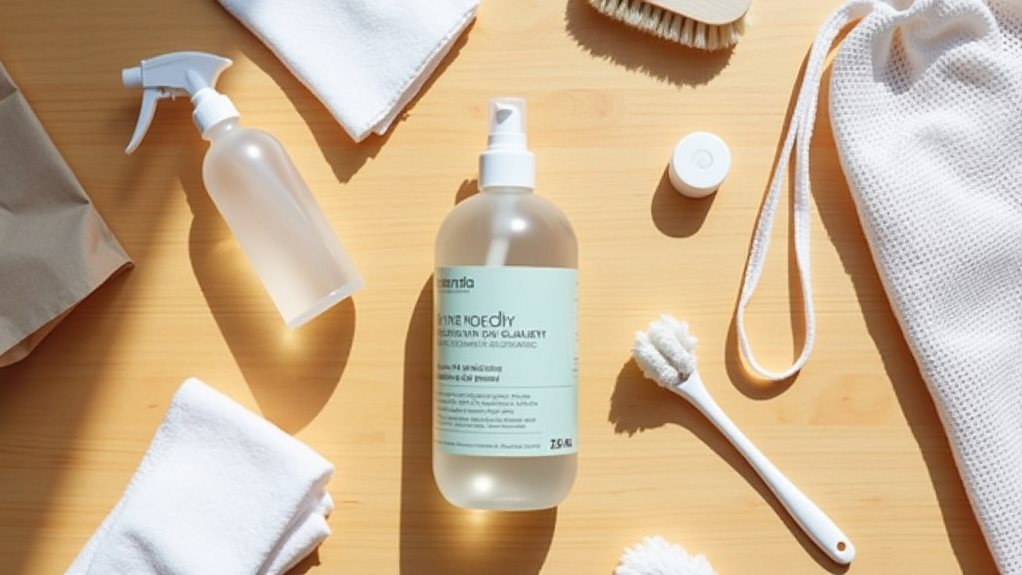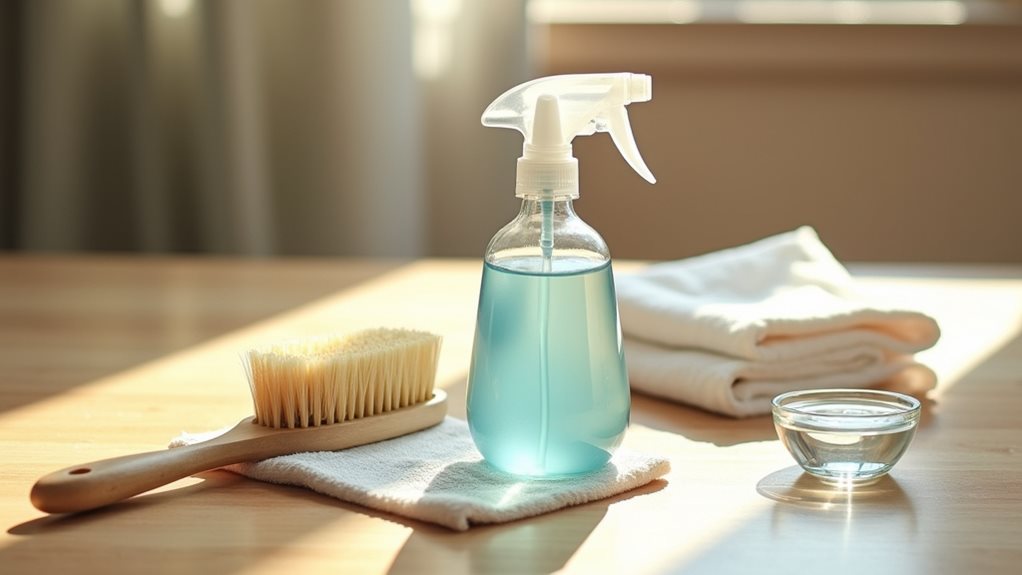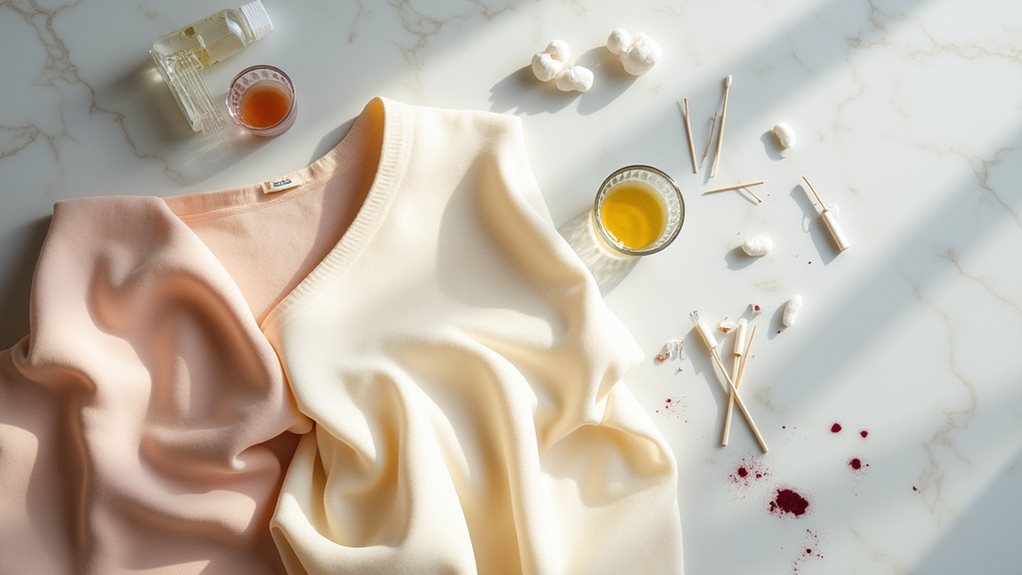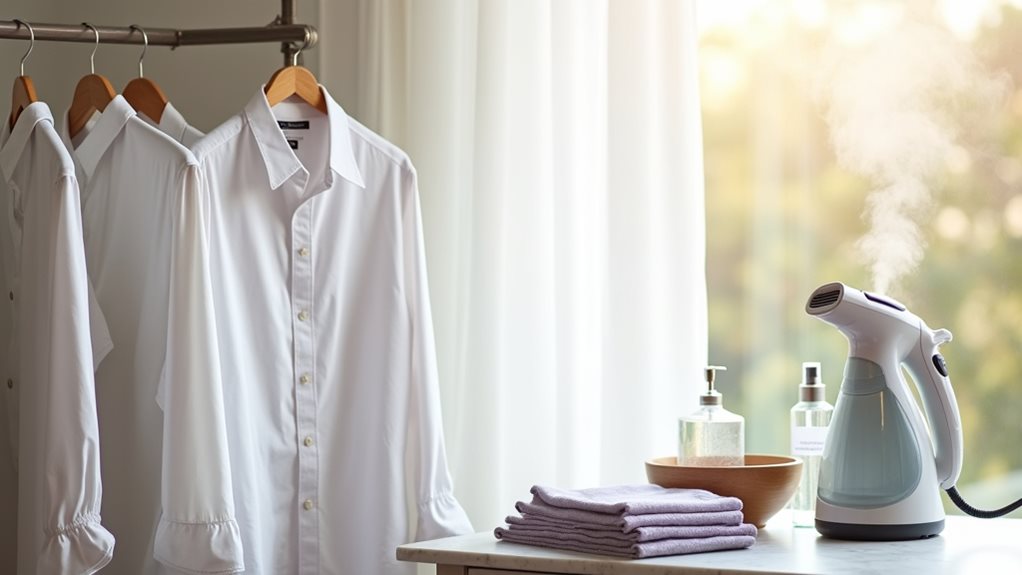You can absolutely dry clean many garments at home using simple household items like mild detergent, white vinegar, and baking soda, though I’ve learned this works best for unstructured pieces made from delicate fabrics like silk, wool, and cashmere that need gentle revitalization rather than heavy-duty cleaning. However, structured garments like customized suits, luxury items, and stubborn stains still require professional services to avoid costly mistakes that could ruin your favorite pieces forever.
Understanding Which Garments Are Suitable for Home Dry Cleaning
When I first discovered home dry cleaning kits tucked away in the laundry aisle, I’ll admit I was skeptical—could these little boxes really handle my favorite silk blouse that I’d been babying for years?
I was skeptical that those little home dry cleaning kits could actually handle my precious silk blouse.
After some experimentation (and one minor mishap with a vintage sweater 😅), I’ve learned that garments suitable for home dry cleaning include delicate fabrics like rayon, silk, wool, and cashmere, especially unstructured pieces.
Your best candidates are items with light stains that need rejuvenating rather than heavy-duty cleaning.
However, you’ll want to stick with professional dry cleaning for structured garments like customized suits.
Always check care labels first, and when you’re unsure about whether you can dry clean clothes at home, do a spot test for colorfastness on hidden seams—trust me on this one.
These home kits work best on garments labeled as “dry clean only” that need occasional maintenance between professional cleanings, using solvent-treated cloths and your dryer’s heat to refresh and remove odors.
Essential Materials and Tools for At-Home Dry Cleaning

The arsenal you’ll need for successful at-home dry cleaning isn’t nearly as intimidating as I initially thought, though I definitely learned this the hard way after my first attempt with nothing but hope and a bottle of regular laundry detergent (spoiler alert: it didn’t end well).
Your necessities include mild detergent, distilled white vinegar, and baking soda for gentle cleaning power, plus a clean microfiber cloth and garment bag to protect your precious pieces.
A steamer works wonders for freshening fabrics, though home dry cleaning kits like Dryel can simplify the entire process with their reusable bags and stain sprays.
Don’t forget a soft-bristle brush for spot cleaning and lint removal, and always work in a well-ventilated area – trust me, proper airflow makes everything better! 🌬️
These kits contain cleaning cloths that are activated by dryer heat to release vapors that penetrate fabric fibers and lift dirt, oils, and odors.
Step-by-Step Process for Dry Cleaning Clothes at Home

Now that you’ve gathered all your supplies and transformed your workspace into a mini dry cleaning station, it’s time to roll up your sleeves and actually tackle those delicate items that have been staring at you from the closet with silent judgment.
Before diving in, always conduct a spot test on a hidden seam – trust me, I learned this the hard way when my favorite silk blouse became a colorful disaster!
Here’s your foolproof process to dry clean at home:
- Fill your clean sink with cool water and one teaspoon of gentle detergent
- Guarantee full submersion by gently swishing garments for 20 minutes
- Press against basin sides to remove excess water without wringing
- Rinse garments thoroughly in fresh, clean water
- Sprinkle baking soda for odor removal, then air dry flat
This gentle home cleaning method helps you avoid exposure to chemical solvents commonly used in traditional dry cleaning while maintaining your garment’s quality and appearance.
Effective Stain Treatment Methods for Delicate Fabrics

When you’re dealing with delicate fabrics like that silk blouse you splurged on last year, you can’t just attack stains with the same aggressive approach you’d use on your old gym clothes – trust me, I learned this the hard way after ruining a beautiful cashmere sweater!
The key lies in understanding that different fabric types require their own gentle treatment methods, whether you’re working with stubborn wine stains on wool or mysterious grease spots on your favorite silk scarf.
You’ll need to master both the art of gentle removal techniques and the science of matching your approach to each fabric’s unique personality, because what works brilliantly on cotton might spell disaster for your most treasured pieces. 😅
Before attempting any cleaning method, always test your chosen technique on an inconspicuous area first to ensure it won’t damage or discolor your precious garment.
Gentle Stain Removal Techniques
Although delicate fabrics can feel intimidating when they’re stained, I’ve learned through countless mishaps with my favorite silk blouse that gentle stain removal actually works better than aggressive scrubbing.
Here’s my tried-and-true approach for treating delicate fabrics without calling a professional dry cleaner:
- Always perform a spot test on a hidden seam first—trust me, discovering color bleeding on visible areas taught me this lesson the hard way 😅
- Create a gentle solution using equal parts white vinegar and water for most stains, including stubborn oil stains.
- Blot rather than scrub, working from outside edges toward the center to prevent spreading.
- Use a soft brush when applying stain remover to protect those precious fibers.
- Consider oxygen bleach during washing for improved brightness, but rinse thoroughly afterward.
Steam cleaning can complement these techniques beautifully. While these home methods work well for many stains, professional dry cleaning uses chemical solvents instead of water to remove dirt and stains without damaging sensitive materials like wool and silk.
Fabric-Specific Treatment Approaches
Since different delicate fabrics behave like temperamental personalities—each with their own quirks and preferences—I’ve discovered that tailoring your stain treatment approach to the specific fabric type makes all the difference between salvaging a beloved garment and accidentally creating an expensive cleaning disaster.
Silk responds beautifully to gentle spot cleaning with equal parts white vinegar and water, while wool prefers this same mixture but with even lighter touches. For cashmere’s finicky nature, I always test any solution on a hidden seam first to avoid heartbreak later.
Oil-based stains need mild detergent applied directly, then gently blotted—never scrubbed, which I learned the hard way with my favorite sweater. After treating any stain at home with your dry cleaning kit, always rinse thoroughly with clean water to prevent residue buildup.
Professional dry cleaning excels at removing oil-based stains that water-based cleaning methods simply cannot eliminate, which is why certain stubborn spots may still require expert treatment despite your best home efforts.
Items That Require Professional Dry Cleaning Services

You’ll want to hold off on attempting certain garments at home, as some pieces truly demand the expertise and specialized equipment that only professional dry cleaners can provide.
Trust me, I learned this lesson the hard way when I tried cleaning my grandmother’s vintage silk blouse and watched it transform into a child-sized disaster 😅.
These items absolutely need professional dry cleaning:
- Luxury fabrics – silk, cashmere, and wool that’s prone to shrinkage or color bleeding
- Structured garments – customized suits with shaped shoulders that’ll lose their form
- Delicate materials – leather, suede, and fur coats requiring specialized solvents
- Valuable clothing – antiques and heirloom pieces you can’t replace
- Special occasion wear – wedding dresses and formal gowns with intricate construction
Additionally, garments with intricate details like beading, sequins, or pleating require professional handling to preserve their specialized construction and appearance.
Sometimes protecting your investment means knowing when to step back.
Alternative Methods to Refresh and Maintain Your Garments

You don’t always need to surrender your favorite garments to professional cleaners, especially when simple steam and air methods can work wonders right in your own home.
I’ve discovered that targeted spot treatment techniques can tackle those pesky stains that seem to appear out of nowhere, saving both time and money while keeping your clothes looking fresh.
These gentle alternatives have become my go-to solutions for maintaining delicate fabrics and extending the life of garments that would otherwise require expensive dry cleaning trips.
For many delicate items, hand washing with wool-safe detergents in cool water can effectively clean garments labeled as “dry clean only” without the need for harsh chemical solvents.
Steam and Air Methods
When traditional washing isn’t an option for your delicate garments, steam and air methods become your best friends for maintaining cleanliness and extending the life of your clothes.
These gentle techniques work wonders without subjecting your precious fabrics to harsh washing cycles that might damage them.
Here’s how you can rejuvenate garments using simple steam and air techniques:
- Place a damp cloth in your dryer with clothes for 5-10 minutes to create steam that eliminates wrinkles and odors.
- Hang garments outside to naturally air out and remove unwanted smells.
- Use a natural bristle clothing brush to gently remove dust from delicate fabrics like wool.
- Spritz persistent odors with vodka-water mixture as a natural deodorizer.
- Add fragrant oils to dryer balls for subtle fragrance while revitalizing.
For professional-level results at home, consider investing in a handheld steamer or garment steamer, which provides more consistent steam distribution and better wrinkle removal than makeshift methods.
Spot Treatment Techniques
Three simple ingredients from your kitchen cabinet can tackle most stains that threaten your favorite garments, and honestly, I wish someone had told me this before I panicked over a wine spill on my best blazer last month.
White vinegar mixed with equal parts water creates an incredibly effective stain remover that’ll surprise you with its gentle power. Always perform a patch test first – trust me on this one!
For spot treatment, you’ll want to use blotting motions rather than aggressive scrubbing, which protects your fabric’s integrity. Oil-based stains respond beautifully to this vinegar solution before rinsing with cold water.
Don’t forget baking soda for stubborn odors; it’ll absorb those unwanted smells like magic ✨
However, some water-based stains or those that have been previously treated with heat may still require professional dry cleaning services for complete removal.




